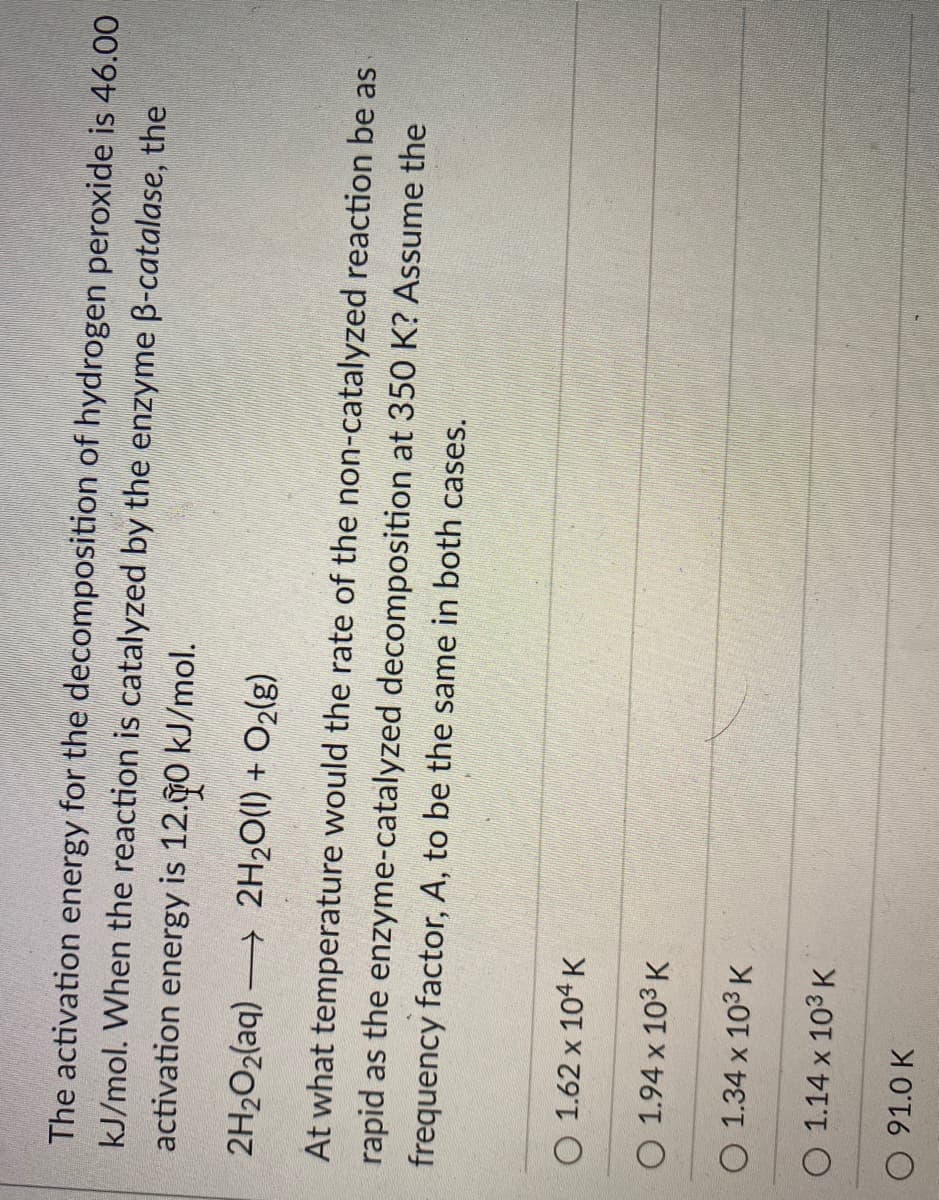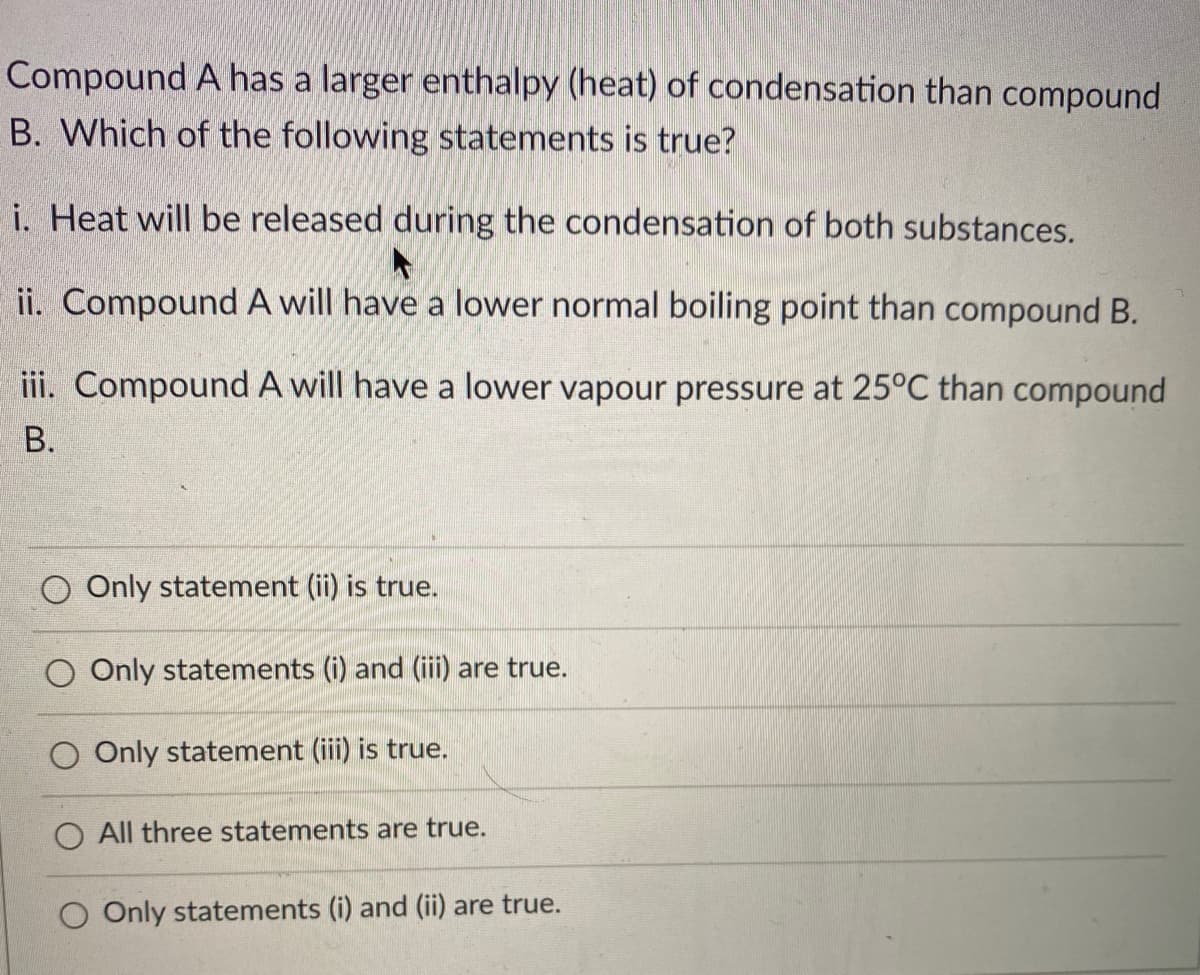The activation energy for the decomposition of hydrogen peroxide is 46.00 kJ/mol. When the reaction is catalyzed by the enzyme B-catalase, the activation energy is 12.00 kJ/mol. 2H2O2(aq) 2H2O(1) + O2(g) At what temperature would the rate of the non-catalyzed reaction be as rapid as the enzyme-catalyzed decomposition at 350 K? Assume the frequency factor, A, to be the same in both cases. O 1.62 x 104 K O 1.94 x 103 K O 1.34 x 103 K O 1.14 x 103 K O 91.0 K
The activation energy for the decomposition of hydrogen peroxide is 46.00 kJ/mol. When the reaction is catalyzed by the enzyme B-catalase, the activation energy is 12.00 kJ/mol. 2H2O2(aq) 2H2O(1) + O2(g) At what temperature would the rate of the non-catalyzed reaction be as rapid as the enzyme-catalyzed decomposition at 350 K? Assume the frequency factor, A, to be the same in both cases. O 1.62 x 104 K O 1.94 x 103 K O 1.34 x 103 K O 1.14 x 103 K O 91.0 K
Chemistry: The Molecular Science
5th Edition
ISBN:9781285199047
Author:John W. Moore, Conrad L. Stanitski
Publisher:John W. Moore, Conrad L. Stanitski
Chapter11: Chemical Kinetics: Rates Of Reactions
Section: Chapter Questions
Problem 80QRT: When enzymes are present at very low concentration, their effect on reaction rate can be described...
Related questions
Question

Transcribed Image Text:The activation energy for the decomposition of hydrogen peroxide is 46.00
kJ/mol. When the reaction is catalyzed by the enzyme B-catalase, the
activation energy is 12.0 kJ/mol.
2H202(aq) 2H20(1) + O2(g)
At what temperature would the rate of the non-catalyzed reaction be as
rapid as the enzyme-catalyzed decomposition at 350 K? Assume the
frequency factor, A, to be the same in both cases.
O 1.62 x 104 K
O 1.94 x 103 K
O 1.34 x 103 K
O 1.14 x 103 K
O 91.0 K

Transcribed Image Text:Compound A has a larger enthalpy (heat) of condensation than compound
B. Which of the following statements is true?
i. Heat will be released during the condensation of both substances.
ii. Compound A will have a lower normal boiling point than compound B.
iii. Compound A will have a lower vapour pressure at 25°C than compound
В.
Only statement (ii) is true.
O Only statements (i) and (iii) are true.
Only statement (iii) is true.
O All three statements are true.
O Only statements (i) and (ii) are true.
Expert Solution
This question has been solved!
Explore an expertly crafted, step-by-step solution for a thorough understanding of key concepts.
This is a popular solution!
Trending now
This is a popular solution!
Step by step
Solved in 3 steps

Knowledge Booster
Learn more about
Need a deep-dive on the concept behind this application? Look no further. Learn more about this topic, chemistry and related others by exploring similar questions and additional content below.Recommended textbooks for you

Chemistry: The Molecular Science
Chemistry
ISBN:
9781285199047
Author:
John W. Moore, Conrad L. Stanitski
Publisher:
Cengage Learning


Chemistry: An Atoms First Approach
Chemistry
ISBN:
9781305079243
Author:
Steven S. Zumdahl, Susan A. Zumdahl
Publisher:
Cengage Learning

Chemistry: The Molecular Science
Chemistry
ISBN:
9781285199047
Author:
John W. Moore, Conrad L. Stanitski
Publisher:
Cengage Learning


Chemistry: An Atoms First Approach
Chemistry
ISBN:
9781305079243
Author:
Steven S. Zumdahl, Susan A. Zumdahl
Publisher:
Cengage Learning

Chemistry
Chemistry
ISBN:
9781305957404
Author:
Steven S. Zumdahl, Susan A. Zumdahl, Donald J. DeCoste
Publisher:
Cengage Learning

Chemistry: Principles and Practice
Chemistry
ISBN:
9780534420123
Author:
Daniel L. Reger, Scott R. Goode, David W. Ball, Edward Mercer
Publisher:
Cengage Learning

Chemistry & Chemical Reactivity
Chemistry
ISBN:
9781337399074
Author:
John C. Kotz, Paul M. Treichel, John Townsend, David Treichel
Publisher:
Cengage Learning